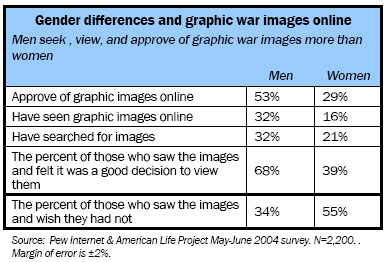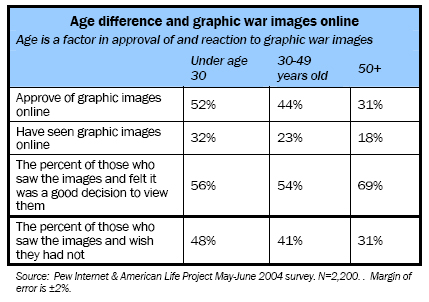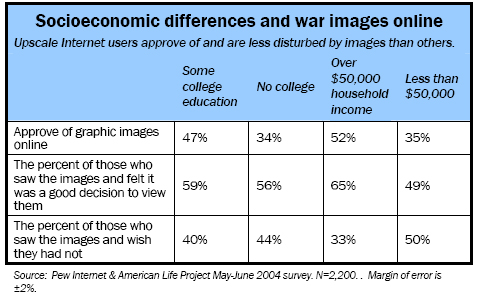Men pursue and consume the news online more than women do.
The popularity of getting news from the Internet has grown over the years, with additional boosts following major news events like September 11 or the start of the Iraq war. Since 2000, when the Pew Internet & American Life Project began tracking participation in Internet activities, men have consistently shown that they are more likely than online women to have used the Internet to get news. In the latest figures, 77% of men have gone online to get news compared to 66% of women.

These gender-related differences are also evident when the issue focuses on the images that are available online. Men and women behave differently in how they gather news, consume news, and in their attitudes about news presentation.
Men have followed more war-related news than women. Some 56% of American men have seen images in the mainstream press of the American contractors killed in Fallujah compared to 48% of women; 79% of online men have seen Iraqi prisoner images compared to 73% of women; 62% of men have seen images relating to Nicholas Berg, the young American murdered by Islamic terrorists, compared to 57% of women. When it comes to war images specifically on the Internet, the findings are consistent. Some 32% of men who are Internet users have seen the more horrific images that available exclusively online, compared to 16% of women.
Men are also more active in using the Internet to seek out news that is not covered in the traditional media. Fully 33% of wired men have actively searched the Internet for general news not covered in the mainstream press, compared to 16% of women. Further, of men who have seen the more graphic online images, 32% of men went looking for the online images that were deemed too graphic or disturbing for television and newspapers, compared to 21% of women.
Finally, 53% of men approve of television and newspaper presentation of war images, compared to 41% of women. Likewise 53% of men approve of the more graphic images being available only on the internet, compared to 29% of women.
Part of the explanation for this gender difference is that women are more unhappy about finding those graphic and disturbing images. While 68% of men felt it was a good decision to go looking for extreme images, only 39% of women felt that way. And 34% of men wished they hadn’t seen them, compared to 55% of women.
Young Internet users are more tolerant of disturbing news in principle, but oldest users are more comfortable in reality.
In previous findings about early Iraq war coverage, young adult Internet users, those 18 – 29 years old, show a greater appreciation than older users of how the Internet can keep them abreast of the news.2 In this survey, younger users continue to demonstrate their enthusiasm for going online for news of all and any sort. Some 29% of the youngest Internet users have looked for general news or photos or videos not covered offline, compared to 23% of users over 30 years old.

And a significantly larger number of the youngest Internet users, 32%, have seen images online that were deemed to graphic or disturbing by traditional media outlets, compared to an overall 21% of older users.
Younger users are more accepting than older Americans of graphic news coverage of the ugliest parts of this war, both by the mainstream media and online. Significantly greater numbers of young Americans, 56%, think the traditional media is within acceptable bounds with the images they have been showing, compared to 48% of those between 30 – 49 years old and 40% of those over 50 years. And significantly larger number of young Internet users, 52%, approve of the more extreme images being available on the Internet, compared to 44% of those 30 – 49 years and 31% of those over 50 years.
However, the tolerance doesn’t translate into comfort when it comes to reality. Of those who actually saw the most graphic online images, 69% of those who were 50 – 64 years old thought they had made a good decision to look at the graphic images, significantly more than the 54% of those 30 – 49 years old, and 56% of the youngest Internet users. Similarly, more young users, 48% wished they hadn’t seen the images, compared to 41% of those 30 – 49 year olds, and 31% of those 50 – 64 years old.
Upscale Internet users tolerate and absorb disturbing news better than others.
Upscale Americans, those with higher education and income levels, are more tolerant of the disturbing war coverage they see both online and in the mainstream press. These Americans agree that the mainstream media is presenting appropriate material. Some 53% of those with at least some college education think so, compared to 41% of those with less education. Similarly, 52% of those with family incomes above $50,000 approve, compared to 44% of those with lower incomes.
Among Internet users, we find a similar degree of tolerance for the more graphic online imagery. 47% of those with at least some college education approve of the more extreme online imagery available, compared to 34% of those with less education. And 52% of those with incomes at least $50,000 approve, compared to 35% of those with lesser incomes.

The group of upscale Internet users didn’t either go looking for or see the most graphic online images in greater numbers than less upscale users. But the upscale users who did see them were more likely to feel they had made a good decision in viewing them. 59% of those with at least a college education said they made a good decision, 40% said they wish they hadn’t seen them, compared to those with less education, where 56% said they had made a good decision and 44% wish they hadn’t seen them. Similarly, 65% of those with incomes above $50,000 said they had made a good decision, 33% wished they hadn’t seen them. This is compared to those with lower income where 49% said they made a good decision and 50% wish they hadn’t seen them.
All Americans are more approving of the standards of the mainstream press than the Internet for publishing images. Internet users are more approving than non-users of any images that appear.
In the mainstream media, where consumers are presumably more familiar and comfortable with the traditional boundaries of what constitutes acceptable imagery, 47% of Americans think the print and television press are right in showing the kinds of war images they do, compared to 41% who don’t think so. But the tables turn when it comes to online material; more people express their discomfort with the graphic and disturbing war related images that have been appearing uncensored online. Only 40% of Americans approve of the kinds of images available on the Internet — ones that traditional media have decided NOT to show — compared to 49% who disapprove.
Consistent with our findings from the early days of the Iraq war, in which Internet users were more likely than non-Internet users to believe the press was doing a good job covering the war, we find again now that Internet users are more approving of media coverage than non-Internet users. Some 52% of Internet users think the mainstream media are showing appropriate war images, compared to 38% of non-Internet users. Even more dramatically, 47% of Internet users approve of the more graphic imagery that is available online, compared to 29% of non-Internet users.
Yet, even among the most aggressive group, the 28% of Internet users who have actively sought and seen graphic and disturbing images online, there remains more than a quarter of those who have reservations about what they have seen. About three-quarters of those who actively sought and found the graphic online images, 72% said they made a good decision in looking at the images; while 24% wish they hadn’t seen them, and 4% said both.
Both Democrat and Independent Internet users are more tolerant of disturbing news images being online than Republican Internet users.
Democrats and Independents are both more likely than Republicans to approve of the war imagery being available both in the mainstream media and online. Some 43% of Republicans think the mainstream media should show the kinds of images they are showing, compared to 62% of Democrats and 55% of Independents. About 42% of Republicans approve of the more graphic images being available on the Internet, compared to 52% of Democrats and 53% of Independents.
But the differences stop there. Behavior and attitudes about the graphic online imagery are similar across partisan boundaries. Some 23% of Republicans have seen the graphic and disturbing images online, compared to 26% of both Democrats and Republicans. Of those who have seen the images, 26% of Republicans actively went searching for them, compared to 29% of both Democrats and Independents. Some 61% of Republicans felt they had made a good decision looking at the images, compared to 58% of Democrats and 56% of Independents.




